HEALTHY FAST FOOD
Kristy Richardson
Do you have a hard time eating healthy because of your busy schedule? For days when you don’t have time to prepare a healthy meal at home, here’s a list of healthy, inexpensive meal options at popular fast food restaurants.
Healthy Fast Food Meals for Under $4

El Pollo Loco
- BRC Burrito and Side of Fresh Vegetables
- Hamburger and Fruit n Yogurt Parfait
- Honey BBQ Sandwich with Green Beans
- Chicken Fajita Pita
- Hamburger with Fruit Cup
430 Calories, 10g Fat, 10g Fiber
McDonald’s
410 Calories, 11g Fat, 2g Fiber
Kentucky Fried Chicken
335 Calories, 4g Fat, 4g Fiber
Jack in the Box
310 Calories, 9.5g Fat, 4g Fiber
370 Calories, 12g Fat, 3g Fiber
Healthy Fast Food Meals for Under $6
- Skinless Chicken Breast, Small Side of Pinto Beans and Small Side of Vegetables
- 6” Sandwich from 6g Fat or Less Menu with a Package of Apple Slices
- Grilled Chicken Classic Sandwich with No Mayo and Apple Slices
- Oven Roasted Twister without Sauce and with Green Beans
- Tender Roast Sandwich without Sauce and with a Small Corn Cob
- Honey BBQ Snacker with Green Beans and a Small Corn Cobb
- Teriyaki Chicken Bowl
- Asian Chicken Salad with Grilled Chicken and Low Fat Chocolate Milk
El Pollo Loco
370 Calories, 4g Fat, 10g Fiber
Subway
265-405 Calories, 3-6g Fat, 7-8g Fiber
McDonald’s
370 Calories, 4.5g Fat, 3g Fiber
KFC
365 Calories, 7g Fat, 4g Fiber
370 Calories, 4.5g Fat, 3g Fiber
305 Calories, 3.5g Fat, 6g Fiber
Jack in the Box
585 Calories, 5.5g Fat, 4g Fiber
365 Calories, 4g Fat, 6.5g Fiber
This information was brought to you by OC Nutrition, Your Trusted Source for Health & Nutrition Advice. OC Nutrition offers nutrition counseling services for Triathica. If you have any questions or would like to schedule an appointment, please contact:
Kristy L. Richardson, MS, MPH, RD, CSSD, CHES
Registered Dietitian & Exercise Physiologist
(949) 933-6788
kristy@ocnutrition.com
www.ocnutrition.com
THE DESERT TRIATHLON
Ron Saetermoe
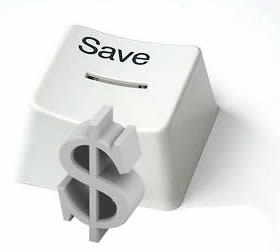 One of my favorite races of the year is coming up quickly, March 7th . . . the Desert Triathlon put on by Klein/Clark Sports.
One of my favorite races of the year is coming up quickly, March 7th . . . the Desert Triathlon put on by Klein/Clark Sports.
If you’re not registered for this event and plan to do it, you’d better sign up soon because I’m sure it will fill up and Brenda says the enrollment is way ahead of last year. In fact, they’ve offered Triathica members (you’ve actually got to be a member, not just a newsletter reader) discounts. $10.00 off the International and $5.00 off the Sprint registration.
To register go to www.active.com and use the codes: sprint10 or international10.
This is a great race for newbies and those that don’t like the swim.
I like this race for a number of reasons:
– It’s an early season race, which allows me to clear the competitive cobwebs.
– It’s close. The race takes place in La Quinta, out near Palm Springs.
– The swim is in Lake Cahuilla, which is a water reservoir so there are no large waves or sharks to worry about.
– The bike and run courses are flat. Other than one hill leaving and entering the park it’s completely flat.
– The weather is usually great (it can get windy).
– A lot of people I know compete there.
– There’s a sprint and Olympic race.
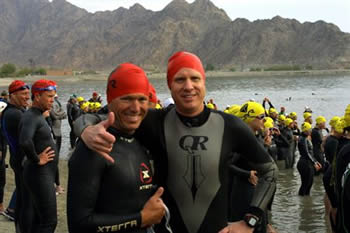
There’s one more reason I like this race and that’s because my pal, Lar Dog Davidson does it every year as well. When we first started competing in this race Larry passed me on the bike early on the second loop. The next year he passed me again on the second loop but later in the race. The next year, later again. Then last year he didn’t catch me until about the first mile on the run. If he races this year I’m hoping to hold him off until at least mile two on the run.
We’ll see . . .
Cheers!
IMPROVE YOUR RUN TIMES THIS SEASON
Jarrett Pflieger
Running off the bike can be a tricky thing to master. Even the best runners on the planet will have a hard time running directly after cycling in a triathlon race. Here are a few tips to help you improve your run times in your next triathlon.
1. Enter running races
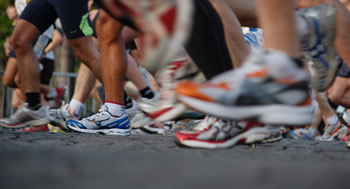 If the only races you do are triathlons, you may be missing out on some serious performance gains. Entering purely running races is a great way to continually test yourself and improve your running performances in triathlon. No matter what we may say, we always work harder in a race than we do in training. Going out and doing a few 5K, 10K, half and full marathons during the year, depending on your race distance, can really help you develop your speed and endurance on the run. You also get more used to the nervousness associated with racing that many people have.
If the only races you do are triathlons, you may be missing out on some serious performance gains. Entering purely running races is a great way to continually test yourself and improve your running performances in triathlon. No matter what we may say, we always work harder in a race than we do in training. Going out and doing a few 5K, 10K, half and full marathons during the year, depending on your race distance, can really help you develop your speed and endurance on the run. You also get more used to the nervousness associated with racing that many people have.
2. Pace yourself
Running after swimming and biking is hard. Running after swimming and biking at full speed without pacing yourself is impossible. To have a good run, you need to save some energy, especially on the bike. Knowing how hard to push it on the bike to get a good time and still have enough for the run is part science and part art form. You need to practice this in order to have your best race possible, which brings us to the next tip.
3. Brick workouts
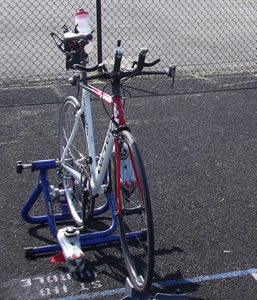 Brick workouts are when you pair two or more exercises together done back-to-back without rest. A very common, and beneficial, brick workout is a bike-run brick. The feeling of running on tired legs is hard to get used to, but brick workouts will help you grow accustomed to and push through the discomfort. Brick workouts also help you determine how fast you can go while still conserving energy for the next leg of the race.
Brick workouts are when you pair two or more exercises together done back-to-back without rest. A very common, and beneficial, brick workout is a bike-run brick. The feeling of running on tired legs is hard to get used to, but brick workouts will help you grow accustomed to and push through the discomfort. Brick workouts also help you determine how fast you can go while still conserving energy for the next leg of the race.
Some people do one large brick every week or every other week. I personally like running a very short distance (one mile or less) after each ride I do, and will do a long run after a bike once a week, maximum. Experiment to see what works best for you.
4. Gain endurance on the bike
It may seem counterintuitive to think about the bike when you are trying to improve your run, but additional endurance on the bike could enable you to run better. Longer bike rides may not make you faster, but they will allow you to feel better and have more energy after riding the same distance at the same speed. Even if you don’t improve your bike times at a certain distance, but do feel and perform better after you ride the distance, it is still a win. Try incorporating some longer rides in your training if you feel your endurance is lacking.
Hopefully these tips will help you become a stronger triathlon runner in 2010. It may be wise to consult a certified coach before attempting any new training program if you are an inexperienced triathlete.
COMING BACK
Ron Saetermoe
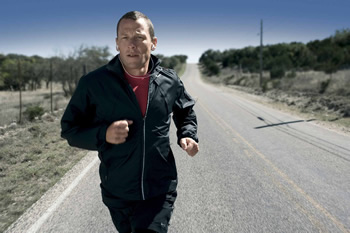 Chances are, if you’re like the majority of triathletes, you haven’t been training much the past several weeks, or months. No, i’m not going to attempt to make you feel guilty for slacking, because I happen to think slacking is good sometimes.
Chances are, if you’re like the majority of triathletes, you haven’t been training much the past several weeks, or months. No, i’m not going to attempt to make you feel guilty for slacking, because I happen to think slacking is good sometimes.
If you think you have to train hard, all of the time, to really perform at your best, you are dead wrong. We all need to give ourselves physical and mental breaks from time to time.
Personally, I’ve still been working out five to six times a week, sometimes twice a day, but most of the efforts have been conservative. After the huge volumes of training leading up to Ironman Arizona I just felt like I needed a break.
The other thing I’ve given myself a break on is my diet. It was my goal to weigh 160 before Ironman Arizona and I reached that goal without sacrificing any strength. And while I’m not generally disciplined with my diet, I did manage to get down to my goal weight.
Since IMAZ, it has been another story. I’ve been eating ice cream, cake and fast food like they’ll be banning it soon. As a result, I’ve gained six pounds since my race. Of course 166 isn’t exactly overweight for a six-foot male, but I definitely feel it.
The one thing I have done is been very disciplined regarding my resistance (strength) training. I’ve been doing two sessions each week for the past three weeks. While I’ve really enjoyed these sessions, I’m also really sore after them. As a result, my other workouts have been compromised because of the muscle soreness.
You have to expect some aches and pains when you reenter the world of triathlon training. The advice here is obvious. Take it slow, and don’t overdo it. On those days when I’m really sore I still try to work out, but will reduce the volume or intensity of these sessions.
For example, last Wednesday I did a very intense hour on the CompuTrainer. While it was really painful, I was so glad I did it. It felt like I still had most of my hard-earned fitness. Later that same day I got on the treadmill with the aim to go another hour. I was fine through the warm-up but just didn’t have “it,” so I stopped after 30 minutes.
So, do I feel guilty for not completing my workout or slacking on my diet? No. If I’m in the same place three weeks from now I’ll be beating myself up for such transgressions, but not now.
It’s a new year and if you’re competing in 2010 it’s time for you to get started. Start back slow. Don’t try to do too much, too soon. If you don’t have “it” on a particular day give yourself a pass. Yes, you’ll want to get very persistent in your training very soon now if you want to have a good season but for now a little slacking is advised.
Cheers!
STAY CONNECTED WITH THE TRIATHLON COMMUNITY
Jarrett Pflieger
One of the great aspects about competing in the sport of triathlon is all the relationships you can form along the way. Training and competing alone is OK, but nothing beats the competitiveness and camaraderie of training and racing with a friend or a group.
Triathlon is a great way to meet new people that share your interests and athletic goals. The social aspect of the sport is what draws many people to it and keeps it growing. Meeting other athletes and staying connected is easier than ever before with all the tools available on the Internet. I’m sure many of you already have a Facebook and Twitter account, but if you don’t, I highly recommend you check them out.

Facebook.com and Twitter.com are great for keeping up with what’s going on in the sport, both locally and abroad. Triathica has accounts with both websites and we routinely send out updates, articles, tips, and announcements that are free to anyone. Aside from joining a local organization like the Orange County Triathlon Club, setting up an account with a social networking website is a great way to connect with other athletes, learn training and racing tips, find training partners, and more.
Check out our Facebook and Twitter posts and create a free account while you are there if you do not have one already. Please introduce yourself; we’d love to meet you.
SO HOW’S THE RESISTANCE TRAINING COMING?
Ron Saetermoe
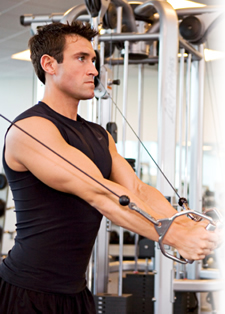 As you know, we’re huge advocates for resistance (strength) training here at Triathica. Jarrett takes the lead but I’m really concentrating on this for 2010. I’m going to need it if I’m going to qualify for Kona. (Did I say that out loud?)
As you know, we’re huge advocates for resistance (strength) training here at Triathica. Jarrett takes the lead but I’m really concentrating on this for 2010. I’m going to need it if I’m going to qualify for Kona. (Did I say that out loud?)
Alyson Wolfe, a grad student at Cal State Fullerton, helped us formulate the Triathica program. It’s really coming together quite well. So well, that I expect we’ll turn it into a book at some point.
I’m validating our program now as the designated Triathica guinea pig. I can tell you that it is definitely kicking my butt! Who would think that you could hurt so badly without lifting 200 lb weights?
Actually, I see my muscle pain as a very good thing. I feel my core, upper body but mostly my legs getting stronger (which is where I really need it).
I had a couple thoughts I’d share with you that may help improve your triathlon performance next year:
1. Get on a resistance-training program. If it’s not ours, get with someone. You’ll see better performance in your races and help reduce injuries.
2. Get started right away. I started my program last week (twice a week) and since I’m so sore, it’s compromising my swim, bike and run training. Delaying your resistance training until you’re already into your season will compromise your training too.
3. Start off easy. It may seem ridiculous doing so few sets with so little weight to start, but a slow build will help you make consistent gains without injuring yourself. The same goes for swim, bike and run training.
4. Many of the exercises can be done at home. Get yourself a fitness ball, some bands and perhaps some dumbbells so you can do many of the exercises at home. Even though I have a 24 Hour Fitness membership AND MY OWN GYM, I still find it convenient to work out at home periodically.
5. Always use proper form. It amazes me to see men and women at the gym hoisting these huge weights and using lousy form. Just like your swimming, cycling and running, form is critically important. Without proper form, you won’t get the maximum benefit and will dramatically increase the chances of injury.
We’d enjoy hearing about some of your resistance training ideas as well.
TRIATHICA NEEDS YOUR HELP!
Ron Saetermoe
 I’ve been very fortunate to have a successful automotive marketing and consulting company for 19+ years. It’s given me a good life and I’ve done some very rewarding work. Let’s face it, Automotive Associates has allowed me to pursue my passion.
I’ve been very fortunate to have a successful automotive marketing and consulting company for 19+ years. It’s given me a good life and I’ve done some very rewarding work. Let’s face it, Automotive Associates has allowed me to pursue my passion.
My passion, as you know, is triathlon. It’s been about two years since I started looking for a niche in the triathlon space and discovered that there weren’t any gyms specializing in triathlon; in the world! Could there be an opportunity there?
Jarrett came on about six months after my epiphany and started researching the market. Of course the research looked good at the time so we developed our business plan and opened the business in June this year.
So far it’s been really great, but we need your help. Mostly we need to spread the word about Triathica and we’ve got a great vehicle to do it with . . . the Triathica Triathlon Roadmap.
By simply entering your email address you get a free copy of the Triathica Triathlon Roadmap – a $19.99 value. How much easier could it be? If you’re already on our email list you can download the book for free right now.
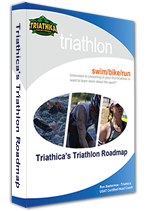
Perhaps the easiest way to help us is to forward this email newsletter to everyone you know and have them sign up for the free copy. Simply point them to the Triathica Triathlon Roadmap box on our homepage at:
www.triathica.com
We really appreciate your help.
Cheers!
PERIODIZE YOUR TRAINING
Jarrett Pflieger
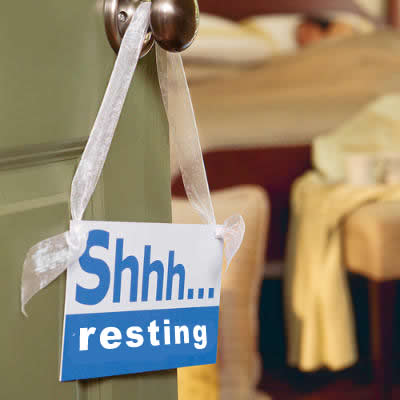 Are you the type of person that does the same workouts week in and week out and constantly tries to improve on your last training session? Please stop. You will save yourself a lot of time and maybe even get faster in the process.
Are you the type of person that does the same workouts week in and week out and constantly tries to improve on your last training session? Please stop. You will save yourself a lot of time and maybe even get faster in the process.
Many athletes fail to realize that our bodies need rest. There’s a little voice that tells us to train faster, longer, and more often or we won’t get better. That is true to some extent, but we forget one very important aspect . . . our bodies need to recover through rest.
That’s right, you can’t get better if you don’t recover and adapt from your workouts, and you can’t recover if you don’t rest. Periodizing your workouts ensure that you get the appropriate amount of rest, while still continuing to vary and build on your workouts to get better. So how do you periodize your current training?
There are many views and opinions on this matter, but one system that seems to work is based off five phases; adaptation, base, build, race, and transition. With each phase, you change up and focus your training to build up a different part of your fitness. Adaptation phase brings you slowly back into training from your off-season. Base phase consists of easy and longer workouts to build up your aerobic base. Build phase continues to build off that base and incorporates more speed work and intensity to increase your speed and endurance. Race phase contains your most intense training sessions leading up to your race, but also incorporates at least a week or two of tapering depending on the distance you are racing. Tapering is reducing your training volume and intensity so your body can absorb your very intense race phase training so that you reach your peak fitness on race day.
With this method, you basically break up your year into five phases of training of nine-weeks each. The remaining weeks in the year are used for whatever you want. Each nine-week “macrocycle” contains three “microcycles” within. The microcycles consist of a moderate week, a maximum week, and then a recovery week. This allows you to start out pretty hard, max out the next week, then recover the third week. Some athletes can do a three-week build then one recover, while others might need to recover after each hard week of training. It really depends on the athlete but a two-on, one-off scheme seems to work for most. By increasing your fitness gradually in cycles, you can better absorb your training and prevent burnout or overtraining.
Just play around with it and see what you can accomplish this season. Definitely consult a certified triathlon coach if you are unsure about putting together your own training plan. Make sure you get plenty of rest and are frequently varying training duration, speed, and intensity to get the most out of your workouts.
DEVELOPING YOUR TRAINING WEEK
Ron Saetermoe

After you’ve mapped out your race year you’ll want to develop your weekly routine. I highly recommend getting into a routine so you can adequately prepare your body and mind.
We all need motivation to train. It might look easy when others get up at 4:00 a.m. when it’s 40 degrees outside and jump into the pool, but it’s not. Getting into a routine and getting committed to it will help a lot. Better yet, recruit (con) another athlete to train with you. Misery loves company!
When developing my weekly plan I look at my schedule day by day. Do I have any routine commitments (like work) to consider? I take tennis lessons Monday evenings with my son, so any training I do must be done before or after that.
Then, I look at how much time I have available (and how much I want to train) each day. Since I’m a morning person I schedule one training session every morning. And since I do work, I schedule another session every Monday – Thursday evening. That’s right, us hardcore triathletes train twice a day!
Fridays for me are recovery days to help me get some rest for the endurance stuff I do on Saturday and Sunday so I only do one workout. Saturday is generally a long bike ride of 3 – 8 hours with a transition run. Sunday is a long run of 1 – 3 hours preceded by a short bike ride. This sequence has me running Sunday on tired legs from Saturday . . . just like my races.
I made a couple changes in my training from last season. The most notable is the addition of resistance (strength) training. If you’ve been reading this newsletter you know what a strong proponent of resistance training Jarrett is. I did my first two sessions this week and they kicked my butt! I see that as a good sign.
The other big change I’m making is reducing my swim workouts and increasing my cycling workouts. I generally finish the swim in the top 10% of guys in my age group but I usually only finish in the top 25% of cyclists. And since the bike portion of the race takes more time, this change makes sense.
The following chart is what a “moderate” week in the “build” period looks like for my Ironman training:

CT = CompuTrainer
TM = Treadmill
Develop your own weekly plan and you’re on your way to a better season.
MAKE 2010 YOUR YEAR!
Ron Saetermoe
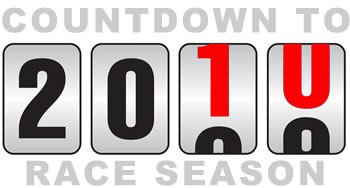 Yesterday I tried signing up for the Carlsbad ½ marathon (I LOVE racing this distance). Sold out! Then I tried signing up for the Vineman 70.3. Sold out! Guess what, it’s not too early to start thinking about your races for 2010. In some cases you’re already too late.
Yesterday I tried signing up for the Carlsbad ½ marathon (I LOVE racing this distance). Sold out! Then I tried signing up for the Vineman 70.3. Sold out! Guess what, it’s not too early to start thinking about your races for 2010. In some cases you’re already too late.
I’m told that Ironman Arizona sold out in 24 minutes. Okay, think about that for a minute. You pay $550.00 for a race a year in advance x 2,400 people = $1.3 million!!! I want that gig!
If you really want to do well racing next year you need to be thinking about the races you’re going to do, sign up, and develop your plan. I normally do about 10 triathlons a year and another 8 – 10 running races. That’s a lot for most athletes, but I love to race.
Racing is fun but if you’re trying to make the podium, you need to do more than just register for races and train – you need a plan of attack.
First, don’t try to do too many races. “Too many” is a relative term. 10 may be too many for some whereas 20 might be just right for others. Use your recovery time as a guide. Older, or less fit athletes will take longer to recover than extremely fit, and younger athletes. You’ll want to have time after your races to fully recover, AND have time to gear up for your next race. If you race EVERY weekend you’re not giving yourself enough time.
Second, pick your “A” races carefully. Your “A” races (1 – 3 per year maximum) are the races you feel you really want to perform your best at. You’ll want plenty of training time and taper time before these races.
Third, think of your “B” and “C” races as “catered workouts.” You’re going to race them but you’re not going to need to be carried off on a stretcher at the end of the race. These races help keep you sharp and give you confidence for your “A” races.
I “age up” in 2010 (I’ll be 35 . . . again) so I’m planning my year VERY carefully. I’ve already registered for Ironman Arizona again because I feel this will be my best chance at qualifying for Kona. I’m also going to try to register for Ironman St. George and Ironman Canada at Ironman California 70.3. We’ll see if I get in.
All of my Ironman races will be “A” races for me. I feel that I’m able to consider three Ironmans “A” races because they’re spread out enough. I’ll have plenty of time to train and taper before my big races.
If you haven’t mapped out your races yet you’d better get on it!
Cheers!


